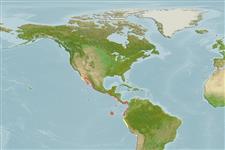Teleostei (teleosts) >
Pleuronectiformes (Flatfishes) >
Cynoglossidae (Tonguefishes) > Symphurinae
Etymology: Symphurus: Greek, syn, symphysis = grown together + Greek, oura = tail (Ref. 45335).
Environment: milieu / climate zone / depth range / distribution range
Ecology
Marine; brackish; demersal; depth range 0 - 60 m (Ref. 9294), usually 0 - 28 m (Ref. 9294). Tropical; 33°N - 5°S, 116°W - 76°W (Ref. 56830)
Eastern Pacific: Gulf of California to Peru.
Size / Weight / Age
Maturity: Lm ? range ? - ? cm
Max length : 26.5 cm TL male/unsexed; (Ref. 124487); common length : 21.0 cm SL male/unsexed; (Ref. 9294); max. published weight: 166.13 g (Ref. 124487)
Dorsal
spines
(total): 0;
Dorsal
soft rays
(total): 98-109;
Anal
spines: 0;
Anal
soft rays: 82 - 92;
Vertebrae: 52 - 57. Body flat and elongated, with an oval anterior border; both eyes on left side; dorsal fin with 98 to 109 rays; anal fin with 82 to 92 rays; caudal fin with 12 rays; body light to dark brown, usually with 6 to 8 transverse bars of contrasting color; lower half operculum on the eyed side with a large dark stain; dorsal and anal fins progressively darker distally (Ref. 55763).
Common over muddy bottoms in estuaries and mangroves (Ref. 9294).
Life cycle and mating behavior
Maturity | Reproduction | Spawning | Eggs | Fecundity | Larvae
Munroe, T.A., F. Krupp and M. Schneider, 1995. Cynoglossidae. Lenguas, lenguetas. p. 1039-1059. In W. Fischer, F. Krupp, W. Schneider, C. Sommer, K.E. Carpenter and V. Niem (eds.) Guia FAO para Identification de Especies para lo Fines de la Pesca. Pacifico Centro-Oriental. 3 Vols. FAO, Rome. (Ref. 9294)
IUCN Red List Status (Ref. 130435)
Threat to humans
Harmless
Human uses
Fisheries: minor commercial
More information
Common namesSynonymsMetabolismPredatorsEcotoxicologyReproductionMaturitySpawningSpawning aggregationFecundityEggsEgg development
ReferencesAquacultureAquaculture profileStrainsGeneticsElectrophoresesHeritabilityDiseasesProcessingNutrientsMass conversion
Tools
Warning: mysqli::__construct(): (HY000/1040): Too many connections in /var/www/html/includes/speciessummary.lib.php on line 2414
Can't connect to MySQL database fbquizv2. Errorcode: Too many connections
